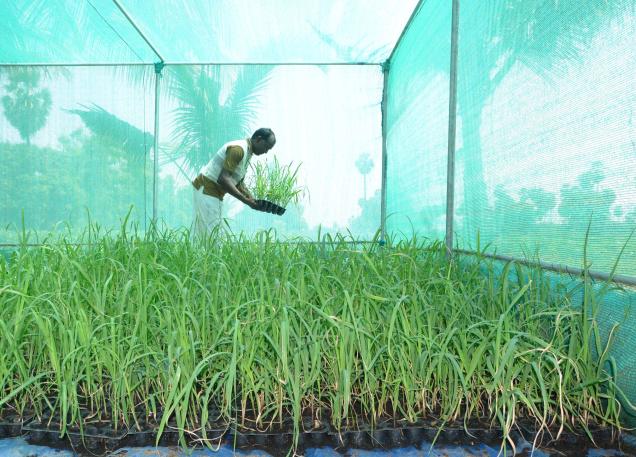
Sugarcane nursery boasts low overheads and high yield
P. Ramanathan, a 42-year-old farmer, sits beside a heap of seed sugarcane in his coconut grove, chipping buds from the cane stalks.
The farmer from Akramesi, a remote village near Pandiyur in Nainarkoil block, is all smiles. He is the first farmer in the district to raise a single bud chip sugarcane nursery, a cost-effective alternative to conventional cultivation.
Optimistic
It has been just two months since he started raising the nursery with the help of Sakthi Sugars, a private sugar mill, but Mr. Ramanathan is optimistic. The single bud sugarcane growing system is gaining popularity among the farmers as a low-cost option.
In the conventional system of sugarcane cultivation, four tonnes of seed cane are cut into pieces with two to three buds and the stalks planted in the furrows. This has posed problems for the farmers in transporting, handling and storing of the seed sugarcane.
In the process, the seed sugarcane undergoes rapid deterioration, reducing the viability of the buds and sprouts. To overcome the snags, reduce the overheads and increase the yield, the Sustainable Sugarcane Initiative (SSI), inspired by the System of Rice Intensification (SRI), had been developed and is fast catching on in Dharmapuri and Erode districts, B. Ilangovan, Deputy Director, Horticulture said.
Shade net house
Mr. Ramanathan is raising the nursery in a shade net house, with a capacity to grow three tonnes of seed sugarcane, and with two hand lever machines for chipping buds provided free of cost by Sakthi Sugars.
“From one tonne of seed sugarcane, we can chip 80,000 buds, which means we can raise as many seedlings in the nursery,” the farmer points out. If he bought one tonne of seed sugarcane for Rs.2,400, he would spend another Rs.2,000 to chip the buds, soak them in a solution of calcium chloride, urea and a fungicide before placing them in trays for sprouting.
Still, he makes a profit of nearly Rs.4,000 per tonne, selling the seedlings each at Rs.1.30 and reselling the budless sugarcane for crushing. After soaking for 10 minutes, the buds are covered in a wet gunny bag and kept indoors for five days before they are placed in sprouting trays filled with manure and stored in the shade net house for the next 15 days.
After sprouting, the seedlings are exposed to sunlight for another 10 days before being removed for planting, he said. He started raising the nursery two months ago, and has already sold 30,000 seedlings. Currently, he has an order for supplying 1.5 lakh seedlings. In 40 days, he expects to chip buds from seven tonnes of sugarcane and raise 5.6 lakh seedlings. This could increase manifold, if he uses an electric powered machine.
Gets a boost
Mr. Ramanathan got a boost recently when Collector K. Nanthakumar, along with a retinue of officials, visited his nursery and was all praise for his venture. Under the system, 100 per cent germination is assured, Mr. Ilangovan assures sugarcane farmers. He said the incidence of pest attack and disease was also reduced significantly.
The National Agriculture Mission helps farmers set up shade net houses and provides a subsidy of Rs.600 per square metre. For wooden shade net houses, the subsidy is Rs.410 per square metre. Nurseries for tomato and chilli could also be raised in shade net houses. At the moment, there are few takers among the local farming community. But with Mr. Ramanathan blazing a new trail, hopefully innovative methods of farming will be the wave of the future.
source: http://www.thehindu.com / The Hindu / Home> News> National> Tamil Nadu / by D.J> Walter Scott / Ramanathapuram – April 30th, 2013